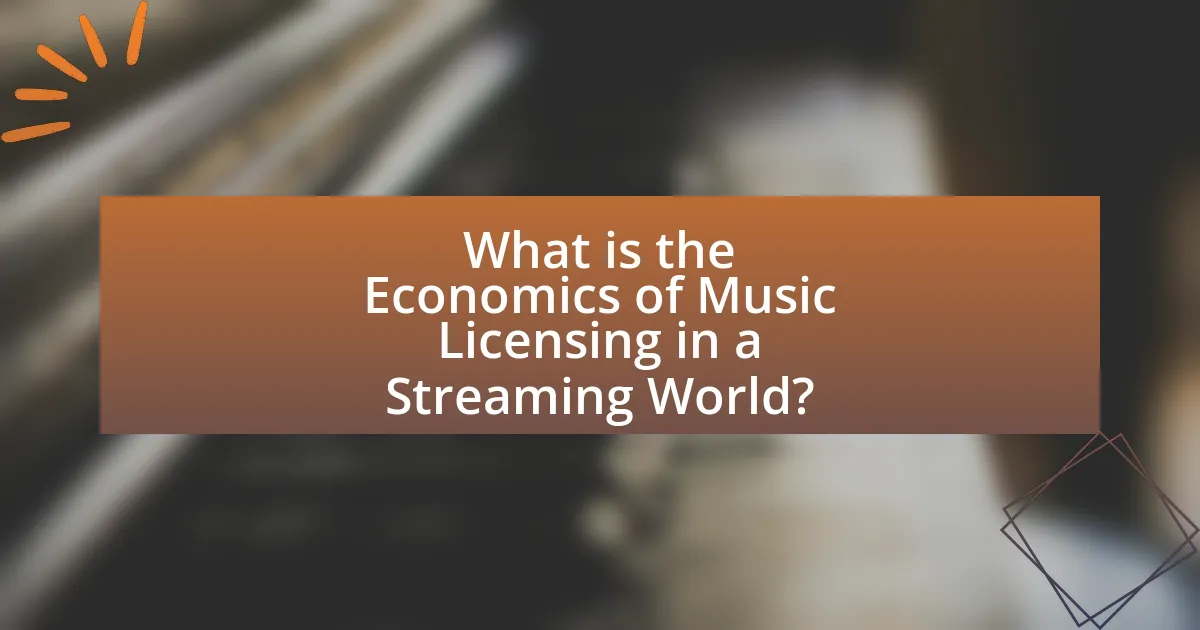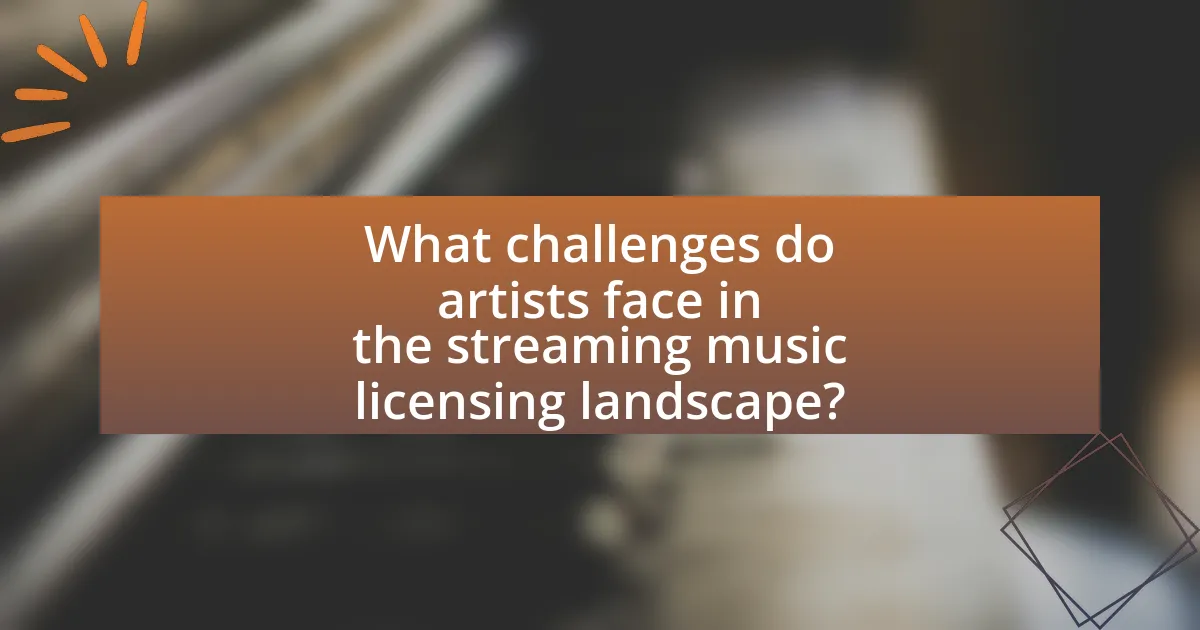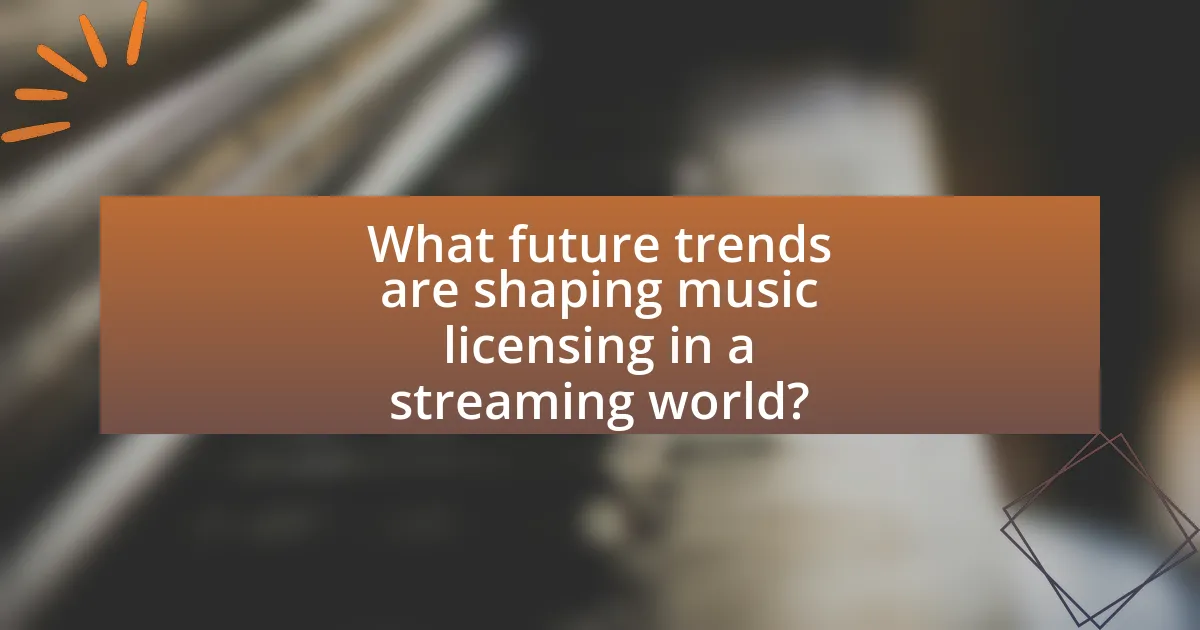The main entity of the article is the economics of music licensing in the context of streaming platforms. The article examines how the rise of streaming services like Spotify and Apple Music has transformed music licensing, shifting from traditional sales to digital access and creating complex licensing agreements. It discusses the differences between traditional and streaming music licensing, the impact of streaming platforms on licensing terms, and the various types of licenses involved. Additionally, the article highlights the challenges artists face regarding low payout rates and the importance of licensing for revenue generation and intellectual property protection. It also explores future trends, including the influence of technology and strategies for artists to navigate the licensing landscape effectively.

What is the Economics of Music Licensing in a Streaming World?
The economics of music licensing in a streaming world involves the financial frameworks and agreements that govern how music is used and compensated in digital platforms. In this context, streaming services like Spotify and Apple Music pay royalties to rights holders, which include songwriters, performers, and record labels, based on the number of streams their music receives. According to the Music Industry Revenue Report, in 2022, streaming accounted for over 80% of recorded music revenue, highlighting the significant economic impact of licensing agreements. These agreements often involve complex calculations, including performance rights, mechanical royalties, and synchronization fees, which determine how much artists and rights holders earn from their work in a digital environment.
How has the rise of streaming changed music licensing?
The rise of streaming has fundamentally transformed music licensing by shifting the focus from physical sales to digital access, resulting in new licensing models and revenue structures. Streaming platforms like Spotify and Apple Music require licenses that allow users to access vast catalogs of music on-demand, which has led to the development of blanket licenses that cover entire catalogs rather than individual tracks. This change has increased the complexity of licensing agreements, as rights holders must navigate multiple agreements with various streaming services. According to the Recording Industry Association of America (RIAA), streaming accounted for 83% of the U.S. music industry’s revenue in 2020, highlighting the financial significance of these new licensing frameworks.
What are the key differences between traditional and streaming music licensing?
Traditional music licensing typically involves a one-time fee for the use of a song in a specific context, while streaming music licensing operates on a model that compensates artists based on the number of streams their music receives. In traditional licensing, fees are negotiated upfront and are often higher for exclusive rights, whereas streaming licenses are usually structured around a percentage of revenue generated by the streaming service, which can lead to lower per-song payouts for artists. Additionally, traditional licensing often requires direct negotiation with rights holders, while streaming platforms generally have blanket licenses that cover a vast catalog of music, simplifying the process for users but complicating revenue distribution for artists.
How do streaming platforms influence licensing agreements?
Streaming platforms significantly influence licensing agreements by dictating terms that prioritize their business models and user engagement strategies. These platforms often negotiate exclusive rights to content, which can lead to higher licensing fees and more restrictive terms for artists and labels. For instance, platforms like Spotify and Apple Music leverage their large user bases to secure favorable agreements, often requiring rights holders to grant them exclusive access to certain tracks or albums. This dynamic has been evidenced by the rise of exclusive releases, such as Taylor Swift’s albums being available only on specific platforms for a limited time, showcasing how streaming services can shape the landscape of music distribution and artist revenue.
What are the main components of music licensing economics?
The main components of music licensing economics include licensing fees, royalties, and the distribution of rights among stakeholders. Licensing fees are the upfront payments made for the right to use music, which can vary based on the type of use and the popularity of the music. Royalties are ongoing payments made to rights holders, typically calculated as a percentage of revenue generated from the use of the music. The distribution of rights involves understanding who owns the rights to the music, including songwriters, publishers, and performing artists, and how these rights are shared in various licensing agreements. These components are essential for determining the financial viability and sustainability of music in a streaming environment, where digital platforms have transformed traditional revenue models.
What types of licenses are involved in music streaming?
The types of licenses involved in music streaming include mechanical licenses, performance licenses, and synchronization licenses. Mechanical licenses allow streaming services to reproduce and distribute copyrighted music, while performance licenses grant the right to publicly perform the music, which is essential for streaming platforms. Synchronization licenses are required when music is used in conjunction with visual media, such as videos or advertisements. These licenses ensure that copyright holders are compensated for the use of their work, reflecting the legal framework that governs music distribution in the digital age.
How are royalties calculated for streaming music?
Royalties for streaming music are calculated based on a combination of factors including the number of streams, the type of streaming service, and the agreements between rights holders and the streaming platforms. Streaming services typically use a pro-rata payment model, where a portion of the total subscription or advertising revenue is allocated to rights holders based on the share of total streams their music receives. For example, if a song accounts for 1% of all streams in a given payout period, it would receive 1% of the total royalties distributed during that time. Additionally, different rights holders, such as songwriters, performers, and record labels, may receive varying percentages of the royalties based on their contractual agreements. This system is supported by data from organizations like the Recording Industry Association of America, which outlines how revenue is shared among stakeholders in the music industry.
Why is music licensing important for artists and creators?
Music licensing is crucial for artists and creators because it ensures they receive compensation for the use of their work. When music is licensed, artists can monetize their creations through royalties, which are essential for sustaining their careers. According to the Recording Industry Association of America (RIAA), the U.S. music industry generated over $12 billion in revenue in 2020, largely driven by licensing agreements. These agreements protect the rights of artists, allowing them to control how their music is used and ensuring they are paid fairly when their work is streamed, broadcast, or used in other media.
How does licensing impact an artist’s revenue?
Licensing significantly impacts an artist’s revenue by providing additional income streams through the legal use of their music in various media. When artists license their work for use in films, commercials, or streaming platforms, they receive royalties, which can substantially increase their overall earnings. For instance, according to the Music Licensing Study by the American Association of Independent Music, artists can earn up to 50% of their total income from licensing deals, highlighting the financial importance of this practice in the modern music industry.
What role does licensing play in protecting intellectual property?
Licensing plays a crucial role in protecting intellectual property by granting legal permission to use copyrighted material while ensuring that creators receive compensation for their work. This legal framework allows artists and rights holders to control how their music is used, preventing unauthorized exploitation and infringement. For instance, in the music industry, licensing agreements specify the terms under which songs can be streamed, downloaded, or performed, thereby safeguarding the economic interests of the creators. According to the U.S. Copyright Office, licensing not only facilitates the distribution of music but also establishes a revenue stream for artists, which is essential in the digital age where streaming has become predominant.

What challenges do artists face in the streaming music licensing landscape?
Artists face significant challenges in the streaming music licensing landscape, primarily due to complex royalty structures and low payout rates. The intricacies of licensing agreements often lead to confusion regarding how royalties are calculated and distributed, resulting in artists receiving a fraction of the revenue generated by their music. For instance, a report from the Music Industry Revenue Report 2022 indicated that artists earn approximately $0.003 to $0.005 per stream on major platforms, which is insufficient for many to sustain a living. Additionally, the lack of transparency in how streaming services report plays and allocate funds further complicates artists’ ability to understand their earnings. This combination of low payouts and opaque systems creates a challenging environment for artists trying to navigate the streaming landscape effectively.
How do streaming payouts affect artists’ earnings?
Streaming payouts significantly reduce artists’ earnings compared to traditional music sales. For instance, platforms like Spotify pay artists an average of $0.003 to $0.005 per stream, which means an artist would need millions of streams to earn a sustainable income. In 2021, it was reported that an artist would require approximately 250 streams to earn just one dollar, highlighting the disparity in revenue generation. This model often favors record labels and streaming services over individual artists, leading to financial challenges for many musicians.
What are the common misconceptions about streaming royalties?
Common misconceptions about streaming royalties include the belief that artists earn substantial income from each stream and that all streaming platforms pay the same rates. In reality, artists typically receive a fraction of a cent per stream, with estimates ranging from $0.003 to $0.005 per stream on platforms like Spotify. Additionally, payment structures vary significantly across different services; for example, Apple Music generally pays higher per-stream rates compared to Spotify. This disparity leads to confusion about the actual earnings artists can expect from their music being streamed.
How do different platforms compare in terms of payout rates?
Different platforms exhibit significant variation in payout rates for music licensing. For instance, Spotify typically pays artists between $0.003 to $0.005 per stream, while Apple Music offers a higher rate, averaging around $0.007 to $0.01 per stream. Tidal stands out with its payout rates, which can reach approximately $0.0125 per stream, making it one of the highest-paying platforms. These differences are influenced by factors such as subscription models, user engagement, and revenue-sharing agreements. According to a 2021 report by the Music Industry Association, the disparity in payouts reflects the platforms’ varying business strategies and market positioning.
What legal issues arise in music licensing for streaming?
Legal issues in music licensing for streaming primarily include copyright infringement, licensing agreements, and royalty distribution. Copyright infringement occurs when music is streamed without proper authorization from the copyright holder, which can lead to legal action. Licensing agreements must be carefully negotiated to ensure that all parties, including songwriters, performers, and record labels, receive fair compensation. Additionally, the complexity of royalty distribution can create disputes, as different streaming platforms have varying models for calculating and distributing payments to rights holders. These issues are underscored by the fact that the U.S. music industry generated $12.2 billion in revenue in 2020, highlighting the financial stakes involved in proper licensing.
What are the implications of copyright infringement in streaming?
Copyright infringement in streaming can lead to significant legal and financial repercussions for both the infringing party and the content creators. When a streaming service uses copyrighted material without permission, it risks facing lawsuits, which can result in hefty fines and damages. For instance, in 2019, the music industry reported losses exceeding $2 billion due to unauthorized streaming, highlighting the economic impact of infringement. Additionally, copyright infringement undermines the revenue streams for artists and rights holders, as they rely on licensing fees for their work. This creates a detrimental cycle where artists may receive less compensation, ultimately affecting the quality and quantity of content available in the streaming market.
How do international laws affect music licensing agreements?
International laws significantly influence music licensing agreements by establishing the legal framework for copyright protection and enforcement across borders. These laws, such as the Berne Convention and the TRIPS Agreement, ensure that creators receive recognition and remuneration for their work internationally. For instance, the Berne Convention mandates that member countries recognize the copyright of works from other member states, which facilitates the licensing process and protects artists’ rights globally. Consequently, music licensing agreements must comply with these international standards to be enforceable, impacting how royalties are collected and distributed across different jurisdictions.

What future trends are shaping music licensing in a streaming world?
Future trends shaping music licensing in a streaming world include the rise of blockchain technology, increased focus on fair compensation for artists, and the growth of user-generated content platforms. Blockchain technology offers transparent tracking of music rights and royalties, which can streamline licensing processes and ensure artists receive fair payments. According to a report by the International Music Summit, the demand for equitable revenue distribution is driving platforms to adopt more artist-friendly licensing models. Additionally, as platforms like TikTok and YouTube continue to expand, they are creating new licensing frameworks to accommodate user-generated content, further influencing how music is licensed in the digital landscape.
How is technology influencing music licensing practices?
Technology is significantly influencing music licensing practices by streamlining the process and enhancing transparency. Digital platforms enable real-time tracking of music usage, allowing for more accurate royalty calculations and faster payments to artists. For instance, services like Spotify and Apple Music utilize automated systems to manage licensing agreements, which reduces administrative burdens and minimizes errors. Additionally, blockchain technology is emerging as a solution to ensure secure and transparent transactions, providing a tamper-proof record of rights ownership and usage data. This shift towards digital solutions is reshaping traditional licensing models, making them more efficient and accessible for both creators and consumers.
What role do blockchain and smart contracts play in music licensing?
Blockchain and smart contracts play a crucial role in music licensing by providing a transparent, secure, and efficient way to manage rights and royalties. Blockchain technology enables the creation of a decentralized ledger that records ownership and usage rights of music, ensuring that all transactions are immutable and traceable. Smart contracts automate the execution of licensing agreements, allowing for real-time royalty distribution based on predefined conditions, which reduces the need for intermediaries and minimizes disputes. For instance, platforms like Audius utilize blockchain to ensure artists receive payments directly and instantly when their music is streamed, demonstrating the practical application of these technologies in enhancing the economics of music licensing in a streaming world.
How might AI impact the future of music licensing?
AI is likely to streamline and enhance the music licensing process by automating rights management and improving royalty distribution. By utilizing machine learning algorithms, AI can analyze vast amounts of data to identify copyright holders and track usage across various platforms, thereby reducing the time and cost associated with traditional licensing methods. For instance, companies like Audoo are already employing AI to monitor music usage in real-time, ensuring that artists receive accurate compensation based on actual plays. This technological advancement not only increases efficiency but also promotes transparency in the licensing process, which is crucial in a rapidly evolving streaming landscape.
What strategies can artists use to navigate music licensing effectively?
Artists can navigate music licensing effectively by understanding the different types of licenses required for their work and utilizing digital platforms that simplify the licensing process. Knowledge of synchronization licenses, mechanical licenses, and performance rights is crucial, as each serves a specific purpose in the distribution and use of music. For instance, synchronization licenses are necessary for music used in visual media, while mechanical licenses are needed for physical and digital reproductions.
Additionally, artists can leverage platforms like Songtrust or DistroKid, which offer services to manage licensing and royalties efficiently. These platforms provide tools that help artists register their works, track usage, and collect royalties from various sources, ensuring they receive fair compensation. According to a 2021 report by the International Confederation of Societies of Authors and Composers, effective management of music rights can increase an artist’s revenue by up to 30%. By combining knowledge of licensing types with the use of digital tools, artists can navigate the complexities of music licensing more effectively.
How can artists maximize their earnings through licensing?
Artists can maximize their earnings through licensing by strategically leveraging their music for various media, including film, television, advertisements, and video games. By understanding the different types of licensing agreements, such as synchronization licenses and mechanical licenses, artists can negotiate better terms that reflect the value of their work. For instance, a study by the Music Industry Research Association found that artists who actively pursue licensing opportunities can increase their income by up to 30% compared to those who do not engage in licensing. Additionally, building relationships with music supervisors and agencies can lead to more consistent licensing opportunities, further enhancing an artist’s revenue stream.
What resources are available for understanding music licensing?
Resources available for understanding music licensing include official websites, educational courses, and industry publications. The U.S. Copyright Office provides comprehensive guidelines on copyright law and music licensing, while organizations like ASCAP and BMI offer resources specifically tailored for songwriters and composers. Additionally, online platforms such as Coursera and Udemy feature courses on music licensing, covering essential concepts and practical applications. Industry publications like “Music Business Journal” and “Billboard” regularly publish articles and insights on current trends and legal aspects of music licensing, making them valuable resources for anyone looking to deepen their understanding of the subject.
